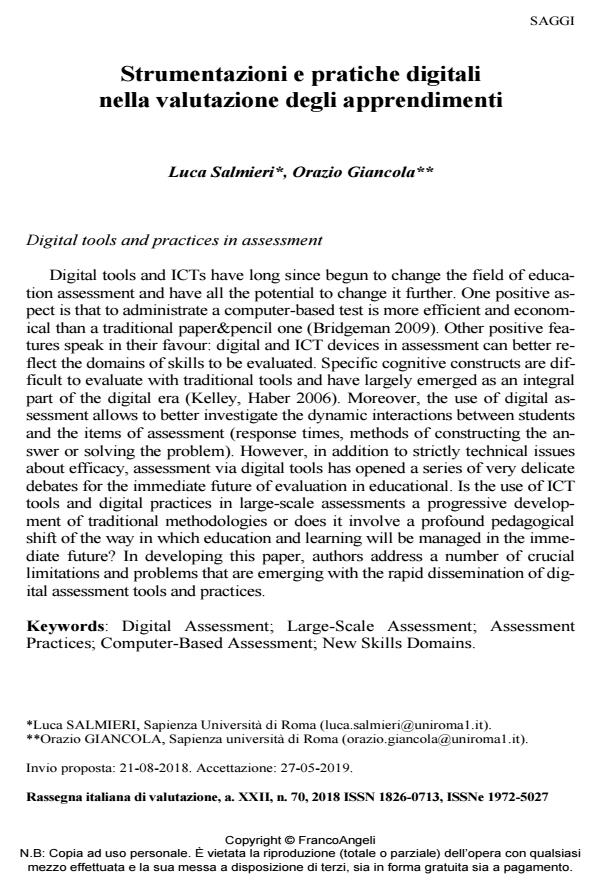Strumentazioni e pratiche digitali nella valutazione degli apprendimenti
Titolo Rivista RIV Rassegna Italiana di Valutazione
Autori/Curatori Luca Salmieri, Orazio Giancola
Anno di pubblicazione 2019 Fascicolo 2018/70
Lingua Italiano Numero pagine 23 P. 75-97 Dimensione file 543 KB
DOI 10.3280/RIV2018-070005
Il DOI è il codice a barre della proprietà intellettuale: per saperne di più
clicca qui
Qui sotto puoi vedere in anteprima la prima pagina di questo articolo.
Se questo articolo ti interessa, lo puoi acquistare (e scaricare in formato pdf) seguendo le facili indicazioni per acquistare il download credit. Acquista Download Credits per scaricare questo Articolo in formato PDF

FrancoAngeli è membro della Publishers International Linking Association, Inc (PILA)associazione indipendente e non profit per facilitare (attraverso i servizi tecnologici implementati da CrossRef.org) l’accesso degli studiosi ai contenuti digitali nelle pubblicazioni professionali e scientifiche
Le strumentazioni digitali e il mondo dell’ICT hanno già da tempo iniziato a modificare il campo della valutazione dell’istruzione e mostrano di possedere tutto il potenziale per modificarlo ulteriormente. Un aspetto di questo processo è legato alle modalità di somministrazione, più efficienti ed economiche rispetto a quelle tradizionali (Bridgeman 2009). Tra gli elementi a loro favore vi è la possibilità di ampliamento e arricchimento che riflettano meglio i domini di competenze da valutare. Vi sono costrutti cognitivi che sono difficili da valutare con i sistemi tradizionali e che sono in buona parte emersi come parte integrante dell’era digitale (Kelley, Haber 2006). Inoltre, la somministrazione di prove in modalità digitale consente di indagare meglio le interazioni dinamiche tra lo studente e il materiale di valutazione (tempi di risposta, modalità di costruzione della risposta o di risoluzione del problema). Tuttavia, oltre alla questione della "economicità" e a quelle più strettamente tecniche, il digital assessment ha aperto una serie di dibattitti molto importanti per l’immediato futuro della valutazione in campo educativo. L’utilizzo di strumentazioni e pratiche di ordine digitale nelle valutazioni di larga scala costituisce uno sviluppo progressivo delle metodologie di valutazione tradizionali oppure comporta una profonda trasformazione pedagogica del modo in cui l’istruzione e l’apprendimento verranno gestite nell’immediato futuro? Gli autori affrontano una serie di limiti e problemi cruciali che emergono con la rapida diffusione delle pratiche di valutazione digitale.
Parole chiave:Valutazione digitale; Valutazioni su larga-scala; Pratiche di valutazione; Prove al Computer; Nuovi costrutti di competenze.
- La ricalibratura delle policy sull’ICT nella scuola italiana: “lezioni” dalla DaD Domenico Carbone, Cristina Calvi, Anna Rosa Favretto, in Cambio. Rivista sulle Trasformazioni Sociali /2024 pp.123
DOI: 10.36253/cambio-15541 - Valutare l’apprendimento precoce di una seconda lingua: rilevanza degli studi longitudinali Lucilla Lopriore, in EuroAmerican Journal of Applied Linguistics and Languages /2020 pp.11
DOI: 10.21283/2376905X.11.195
Luca Salmieri, Orazio Giancola, Strumentazioni e pratiche digitali nella valutazione degli apprendimenti in "RIV Rassegna Italiana di Valutazione" 70/2018, pp 75-97, DOI: 10.3280/RIV2018-070005